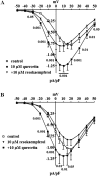The flavonoid scaffold as a template for the design of modulators of the vascular Ca(v) 1.2 channels
- PMID: 21557738
- PMCID: PMC3230815
- DOI: 10.1111/j.1476-5381.2011.01476.x
The flavonoid scaffold as a template for the design of modulators of the vascular Ca(v) 1.2 channels
Abstract
Background and purpose: Previous studies have pointed to the plant flavonoids myricetin and quercetin as two structurally related stimulators of vascular Ca(v) 1.2 channel current (I(Ca1.2) ). Here we have tested the proposition that the flavonoid structure confers the ability to modulate Ca(v) 1.2 channels.
Experimental approach: Twenty-four flavonoids were analysed for their effects on I(Ca1.2) in rat tail artery myocytes, using the whole-cell patch-clamp method.
Key results: Most of the flavonoids stimulated or inhibited I(Ca1.2) in a concentration- and voltage-dependent manner with EC(50) values ranging between 4.4 µM (kaempferol) and 16.0 µM (myricetin) for the stimulators and IC(50) values between 13.4 µM (galangin) and 100 µM [(±)-naringenin] for the inhibitors. Key structural requirements for I(Ca1.2) stimulatory activity were the double bond between C2 and C3 and the hydroxylation pattern on the flavonoid scaffold, the latter also determining the molecular charge, as shown by molecular modelling techniques. Absence of OH groups in the B ring was key in I(Ca1.2) inhibition. The functional interaction between quercetin and either the stimulator myricetin or the antagonists resokaempferol, crysin, genistein, and 5,7,2'-trihydroxyflavone revealed that quercetin expressed the highest apparent affinity, in the low µM range, for Ca(v) 1.2 channels. Neither protein tyrosine kinase nor protein kinase Cα were involved in quercetin-induced stimulation of I(Ca1.2).
Conclusions and implications: Quercetin-like plant flavonoids were active on vascular Ca(v)1.2 channels. Thus, the flavonoid scaffold may be a template for the design of novel modulators of vascular smooth muscle Ca(v)1.2 channels, valuable for the treatment of hypertension and stroke.
© 2011 The Authors. British Journal of Pharmacology © 2011 The British Pharmacological Society.
Figures





Similar articles
-
L-type Ca2+ channels activation and contraction elicited by myricetin on vascular smooth muscles.Naunyn Schmiedebergs Arch Pharmacol. 2003 Dec;368(6):470-8. doi: 10.1007/s00210-003-0836-y. Epub 2003 Nov 15. Naunyn Schmiedebergs Arch Pharmacol. 2003. PMID: 14618297
-
Mechanism of myricetin stimulation of vascular L-type Ca2+ current.J Pharmacol Exp Ther. 2005 May;313(2):790-7. doi: 10.1124/jpet.104.080135. Epub 2005 Jan 21. J Pharmacol Exp Ther. 2005. PMID: 15665142
-
Quercetin antagonism of Bay K 8644 effects on rat tail artery L-type Ca(2+) channels.Eur J Pharmacol. 2008 Nov 19;598(1-3):75-80. doi: 10.1016/j.ejphar.2008.08.016. Epub 2008 Aug 30. Eur J Pharmacol. 2008. PMID: 18789318
-
Cardamonin is a bifunctional vasodilator that inhibits Ca(v)1.2 current and stimulates K(Ca)1.1 current in rat tail artery myocytes.J Pharmacol Exp Ther. 2010 Feb;332(2):531-40. doi: 10.1124/jpet.109.161265. Epub 2009 Nov 18. J Pharmacol Exp Ther. 2010. PMID: 19923439
-
The surge of flavonoids as novel, fine regulators of cardiovascular Cav channels.Eur J Pharmacol. 2017 Feb 5;796:158-174. doi: 10.1016/j.ejphar.2016.12.033. Epub 2016 Dec 22. Eur J Pharmacol. 2017. PMID: 28012974 Review.
Cited by
-
By improving regional cortical blood flow, attenuating mitochondrial dysfunction and sequential apoptosis galangin acts as a potential neuroprotective agent after acute ischemic stroke.Molecules. 2012 Nov 9;17(11):13403-23. doi: 10.3390/molecules171113403. Molecules. 2012. PMID: 23143152 Free PMC article.
-
Mouse sperm membrane potential hyperpolarization is necessary and sufficient to prepare sperm for the acrosome reaction.J Biol Chem. 2012 Dec 28;287(53):44384-93. doi: 10.1074/jbc.M112.393488. Epub 2012 Oct 24. J Biol Chem. 2012. PMID: 23095755 Free PMC article.
-
From in silico to in vitro: a trip to reveal flavonoid binding on the Rattus norvegicus Kir6.1 ATP-sensitive inward rectifier potassium channel.PeerJ. 2018 May 2;6:e4680. doi: 10.7717/peerj.4680. eCollection 2018. PeerJ. 2018. PMID: 29736333 Free PMC article.
-
Extra Virgin Olive Oil Extracts of Indigenous Southern Tuscany Cultivar Act as Anti-Inflammatory and Vasorelaxant Nutraceuticals.Antioxidants (Basel). 2022 Feb 22;11(3):437. doi: 10.3390/antiox11030437. Antioxidants (Basel). 2022. PMID: 35326088 Free PMC article.
-
Vietnamese Dalbergia tonkinensis: A Promising Source of Mono- and Bifunctional Vasodilators.Molecules. 2022 Jul 14;27(14):4505. doi: 10.3390/molecules27144505. Molecules. 2022. PMID: 35889386 Free PMC article.
References
-
- Akiyama T, Ishida J, Nakagawa S, Ogawara H, Watanabe S, Itoh N, et al. Genistein, a specific inhibitor of tyrosine-specific protein kinases. J Biol Chem. 1987;262:5592–5595. - PubMed
-
- Carosati E, Sforna G, Pippi M, Marverti G, Ligabue A, Guerrieri D, et al. Ligand-based virtual screening and ADME-tox guided approach to identify triazolo-quinoxalines as folate cycle inhibitors. Bioorgan Med Chem. 2010;18:7773–7785. - PubMed
Publication types
MeSH terms
Substances
LinkOut - more resources
Full Text Sources
Other Literature Sources
Miscellaneous

